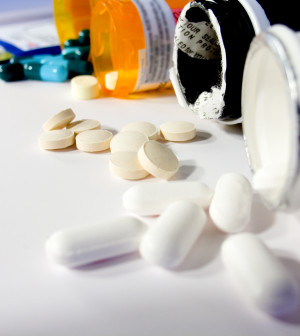- Skip Storing This Everyday Product in the Fridge Door
- Green Tea + B3 Pairing May Boost Brain Health
- Navigating Your Midlife Crisis: Embracing New Possibilities
- City Raccoons Showing Signs of Domestication
- Mapping the Exposome: Science Broadens Focus to Environmental Disease Triggers
- One Week Less on Social Media Linked to Better Mental Health
- Your Brain Changes in Stages as You Age, Study Finds
- Some Suicide Victims Show No Typical Warning Signs, Study Finds
- ByHeart Formula Faces Lawsuits After Babies Sickened With Botulism
- Switch to Vegan Diet Could Cut Your Greenhouse Gas Emissions in Half
Too Few U.S. Teens Getting HPV Vaccine: CDC


Most boys and a large portion of girls in the United States have not received even a single dose of the cancer-preventing human papillomavirus (HPV) vaccine, even though some slow progress has been made, federal researchers report.
Four out of 10 girls and six out of 10 boys, aged 13 to 17, have not started the recommended HPV vaccine series, leaving them vulnerable to developing a wide array of cancers, according to the U.S. Centers for Disease Control and Prevention.
Every year, about 27,000 women and men in the United States are diagnosed with a cancer caused by HPV infection, the CDC said.
HPV vaccination could prevent the majority of these cancers from ever developing, said Dr. Anne Schuchat, assistant surgeon general and director of CDC’s National Center for Immunization and Respiratory Diseases.
Nearly all cervical and anal cancers are caused by HPV, the CDC said. The virus, which is sexually transmitted, also causes about 70 percent of throat cancers, 75 percent of vaginal cancers and 63 percent of cancers of the penis, according to the CDC.
“HPV vaccine prevents cancer,” Schuchat said. “I know many parents are starting to think about their back-to-school lists, and it’s a great time to make sure your preteens have gotten all their recommended vaccines.”
Data for the latest report came from the CDC’s 2014 National Immunization Survey-Teen. The survey included almost 21,000 teens aged 13 to 17 in 2014.
The latest estimates show that 60 percent of adolescent girls and 42 percent of adolescent boys had received one or more doses of HPV vaccine by 2014, the survey noted. This was an increase of 3 percent for girls and 8 percent for boys from 2013.
But HPV vaccinations still lag far behind two other vaccines also recommended for kids 11 and 12: the meningitis and Tdap vaccinations.
About 87 percent of teenagers have received at least one dose of the Tdap vaccine, which protects against tetanus, diphtheria and pertussis (whooping cough), and 79 percent have received the meningitis vaccine, the CDC reported.
In addition, the improved numbers are due to just a handful of states and local areas that achieved more substantial increases in HPV vaccine coverage than the rest of the nation, Schuchat said.
“We are seeing patchwork progress,” she said. “There’s still quite a range in HPV vaccination coverage across the country.”
The problem isn’t the cost of the HPV vaccine, as private insurers are required to cover it without co-pay and government programs are available to provide it free to children in low-income families, Schuchat said.
Instead, she feels the main roadblock to progress is that doctors are not making a strong enough recommendation to parents in favor of the HPV vaccine.
“Surveys of parents identify not receiving a recommendation as a critical gap,” Schuchat said. “We have asked parents about whether cost is an issue, and that is not showing up in our list of the top concerns.”
The CDC is urging family doctors to “recommend HPV vaccines in the same way and on the same day you recommend other routinely recommended teenage vaccinations,” she said.
“A provider recommendation is really important, and parents are waiting for that on those doctor visits,” she concluded.
The states that significantly increased HPV vaccinations include Georgia, Illinois, Montana, North Carolina and Utah. The report also noted large increases in Chicago and Washington, D.C., which contributed to the overall progress.
“The large increases in these diverse parts of the country show us it is possible to do much better at protecting our nation’s youth from cancers caused by HPV infections,” Schuchat said. “We are missing crucial opportunities to protect the next generation from cancers caused by HPV.”
Georgia, Utah and the two cities received federal funding from the CDC in 2013 to improve HPV vaccination coverage, and that money appears to have helped, the report said.
Single-dose HPV vaccination coverage is highest in Rhode Island, where 76 percent of girls have received at least one shot, and lowest in Kansas, where only 38 percent of girls have started the series.
About 57 percent of girls in Washington, D.C., have received the full series of three shots, compared with just 20 percent in Tennessee, the findings showed.
The first vaccine to prevent HPV infection received its license in 2006. It initially was recommended only for girls, to protect them against cervical cancer, but in 2011 the CDC revised its guidelines to recommend HPV vaccination for boys as well.
The CDC now recommends the vaccine for girls and boys at age 11 to 12. There are three vaccines that can prevent infection with certain cancer-related strains of HPV: Cervarix, Gardasil and Gardasil 9.
The survey results were released July 30 in the CDC’s Morbidity and Mortality Weekly Report.
More information
For more information on HPV, visit the U.S. Centers for Disease Control and Prevention.
Source: HealthDay
Copyright © 2025 HealthDay. All rights reserved.










